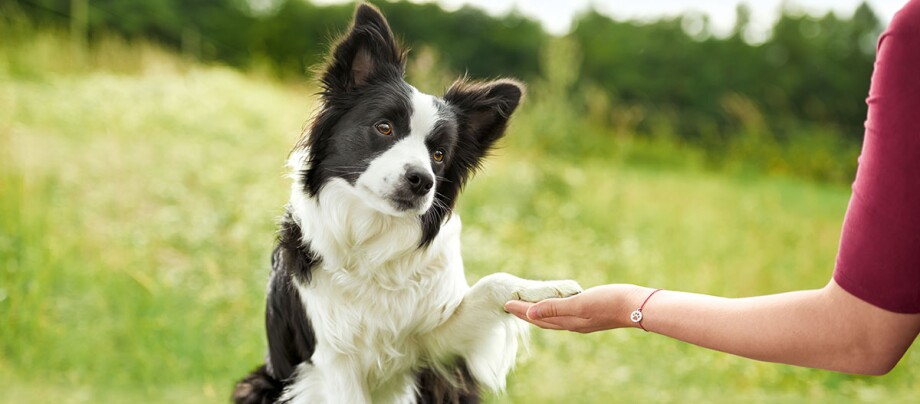Standard Dog Commands: How Your Dog Learns the Most Important Ones
07.10.2022 - Reading time: 3 minutes

The long history of the domestication of dogs is based upon successful team work with humans. Dogs were, and have been, great help when hunting, managing herds and protecting dwellings and farms. Some standard commands have been established, which you will find set out below.
Does your dog understand commands?
The intelligence of dogs has long been the focus of science. It has been proven that clever dogs can understand and implement a range of up to 250 words. On top of that they can interpret and abstract facial expressions, gestures and behaviour of the people that they know.
Words that are linked to things or commands are not difficult for dogs, even if some individuals are brilliant and others are, shall we say, less so.
Here is a classic example to show how much they understand: whilst you weren’t watching, your dog did something wrong. You come along and your dog looks guiltily up at you. They don’t actually feel bad, but they can retroactively make a link between what they did and that they shouldn’t have done it.
Why are commands important when training dogs?
When training a young dog basic commands, which are spoken rather than being given by a signal, are important for harmonious co-existence. This is because your young dog must learn what they may and may not do. Commands such as “good” and “no” are useful. Basic commands not only serve to control and keep your pet in line, but they also keep them safe. You can build further training on top of these commands: desired behaviour is rewarded, inappropriate behaviour is made clear verbally.
There are certain commands that will get your dog to sit, lie down or walk to heel. As soon as these basic commands have been learnt, then more complex ones can follow, such as encouraging certain behaviours which vary, depending on the environment. These may include following a scent, retrieving something or simply giving a paw or begging for something when interacting with humans.
How do I teach my dog commands?
To do this, you need to form a connection between the signal and the behaviour you expect. Patience and consistency are required. Some dogs will pick up quickly what you want from them. Others need a bit more time. Where possible, break up the learning process into the smallest possible steps which are easier to understand. Always practise for a few minutes at a time, a few times a day instead of long sessions. The attention span of dogs, particularly young ones, is relatively short. Overload due to training that is too long or too difficult can mean your dog loses its enjoyment in what you’re doing.
Examples to practise commands
- “No!”: If they do something wrong, say “no” in a short, loud voice to your puppy and keep a serious attitude so that your dog is startled and stops what they are doing. It is important that your pet is distracted immediately and is praised for stopping, instead of simply being confused for a moment before carrying on with the inappropriate activity. This way your dog will internalise the command and connect with the idea of stopping.
- “Come/here/heel”: Attempt to make eye contact with your dog, bend down or squat and get their attention with the command. If your dog comes to you, praise them and reward them straight away. This makes “coming” comfortable for them. However, if your young dog runs away, don’t go after it. Otherwise this becomes a fun game of chase (for them). Walk away, and as soon as the dog tries to catch up with you, give the command and praise them. For safety, if they have still not understood the command “come/here” you should put them on a lead when out walking. Don’t get annoyed if they dawdle, this can have the opposite effect of what you’re trying to achieve.
- “Sit”: Get your dog’s attention with a treat but hold your hand so that your dog has to look up at you and give them the command. To keep the treat in view, they will have to sit and you can give them plenty of praise. If they jump or do something similar you need to say “no”. Give your dog the treat when they are actually sitting and slowly increase the time between them sitting and you giving them the treat.
- “Bed/lie down”: Hold a treat in a closed hand and move it to the floor in front of your sitting dog. Whilst doing so, say give the command. If your dog follows your hand with its nose and then lies down, praise them.
Important: Work in small steps. At the beginning, you can reward an attempt without the command being executed perfectly. For example, with the command “lie down”, if they lie down for a moment, reward them. Then you can allow them to get up. As time passes, you can increase the time they need to stay lying down to get a treat. As soon as the commands have been understood sufficiently, you can use treats less and less and replace them with praise and petting.
Dog command list
In English we have a set of established command words.
The most important dog commands
- Sit – sit down
- Lay down (also bed) – lie down
- Come/here/heel – come to me
- Drop – to stop doing something or drop an object
- No – stop doing something
- Look – pay attention to something
- Go on – don’t stop, don’t be distracted
- Stop – stop a current activity, such as a game
- Seek – follow a scent or find something
- Fetch – retrieve something



